Your handy 1997–2001 (DC2) Acura Integra Type R buyer’s guide
We returned from our drive of the 2024 Integra Type S celebrating Acura’s return to the simple joy of the original hot Integra, the Type R. So, we decided to revisit this buyer’s guide, originally published in November of 2021. Here it is, updated with data from the spring 2023 edition of the Hagerty Price Guide. Happy shopping!
If you happened to graduate college around 1995, the third-generation (DC2) Integra was practically issued to you when your college president handed you your BA in Travel and Tourism. The Acura Legend cemented Honda’s luxury brand reputation here in the United States, but it was the third-generation Integra that put generous American butts in seats. These entry-level premium cars sold at an average of about 50,000 units a year. If you were particularly interested in performance, you were one of the very few who purchased a DC2 Integra Type R.
The DC2 backstory
Honda waded into DC2 (shorthand for third-generation, VTEC-equipped Integras) production with some trepidation, and a crucial mistake, at least at home. Worldwide, the brand sold nearly a million of the prior-generation Integras in 10 years. And 550,000 examples came to the United States alone.
“In order to meet the challenges of the ’90s,” reads the bilingual Japanese magazine Car Design on the eve of the DC2’s launch in 1994, “Honda R&D’s design organization has been revamped, and the young team under its new leader, General Manager Hiroshi Zaima, has added a new active, powerful character to Honda cars,” wrote Takehiko Morozumi.
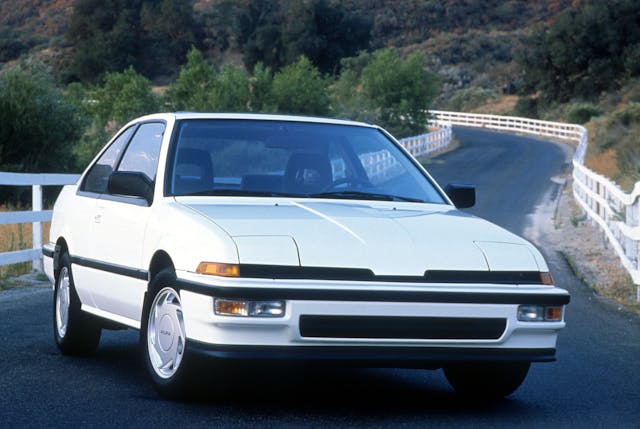
Designs for the third-generation Integra began in 1989, with entries from two camps: At the Wako R&D studios, Honda designers worked on one proposal. On the other side of the planet, at Honda R&D Americas, Inc. (HRA), design chief Douglas Halbert had a team working on a second proposal. Since the three-door hatch was primarily aimed at the North American market, the HRA team wielded a lot of influence. In the end, their “hot-blooded Italian” design won out, though a lot of refining happened at the Wako R&D studios, with Akio Higuchi in charge of the final packaging.
“Putting such experienced designers . . in a supporting role was a new attempt for Honda design,” wrote Takehiko Morozumi. The design included a “tense surface treatment, arced drip line, wedge shape, short rear overhang, and four rounded headlights using projector lamps.” That fascia would prove controversial in the home market, forcing Honda to scrap it for a more conventional nose, but in the U.S. and elsewhere, the look stuck.
Remember that 1994 was the Wild West of headlamp design: There were still new vehicles hitting the streets with sealed beams, while most of the industry was moving toward composite lamps with halogen bulbs. But nobody had a projector beam like the Integra: According to Car Design magazine, those lamps materialized at the behest of Soichiro Honda himself, who cautioned that he did not want to see a design with retractable headlamps if, when raised, the lights would impact the car’s aerodynamic profile.
Earlier prototypes had even more dramatically styled interiors, though this one was unique for its day. “Our brief was to produce a Honda that was different from previous models,” said interior chief designer Kenji Iyanagi, “so we did away with the tray-type dashboard and proposed a more open design with a slanted surface.”
The Akira Shimoyama design was just what young Americans were after. Even in the face of a relentless recession, the 1994 Integra sold at a pace of 67,426 units in the 1994 model year, and another 61,316 in 1995. The GS-R trim level was the top performance iteration up until 1997, but the DC2 Type R would nearly eradicate it from most people’s memory.

The Acura Integra Type R is now considered a (pardon the pun) legend, but at the time, it was in the mode of a number of small Japanese hatchbacks and sedans that were stripped and modified into performance cars. Nissan had the Sentra SE-R in 1990, and Toyota offered the AE86. The Integra Type R was only really “upscale” if you were American and bought one from an Acura dealer. The first year it wasn’t even available with air conditioning, but it had the engineering and design prowess within to make what Road & Track called “the best-handling front-drive car of all time.”
1997

The Integra Type R (“ITR,” to fans) was introduced with its own six-page brochure in 1997, but the publication was really just a two-page spec sheet and a three-page foldout of the car in profile. No matter, the 195-hp VTEC four-cylinder featured a large-diameter throttle body and single-plane intake that helped contribute to its eye-popping high-rpm performance. The engine was essentially hand-built, with hand-polished intake ports, higher-lift cams, 12 percent lighter intake valves, 10.6:1 compression ratio pistons, a forged crank with eight counterweights, and an aluminum oil cooler.
Looking back on it, the DC2 Type R wasn’t powerful on paper. In real life, however, it was intoxicating; it made its max horsepower just 400 rpm short of its 8400-rpm redline. At 2643 pounds, the ITR wasn’t all that light for the era, despite being 67 pounds lighter than the GS-R. But Honda’s legendary double-wishbone suspension sat front and rear, and there were 14 percent larger brake rotors at each corner. Between the Type R’s engine and transmission was a lightened flywheel and a heavy duty, hydraulically actuated clutch for more positive shifts. The five-speed gearbox—the only one available on a Type R—had closer ratios. A torque-sensitive Torsen differential helped the front wheels dig under maximum load in the corners. The monocoque chassis was stiffened for “exceptional rigidity,” making the best use of the lowered suspension with its stiffer springs and firmer shocks. The lightweight, five-lug 6.0JJx15 wheels were wrapped in Bridgestone Potenza RE010 summer rubber.
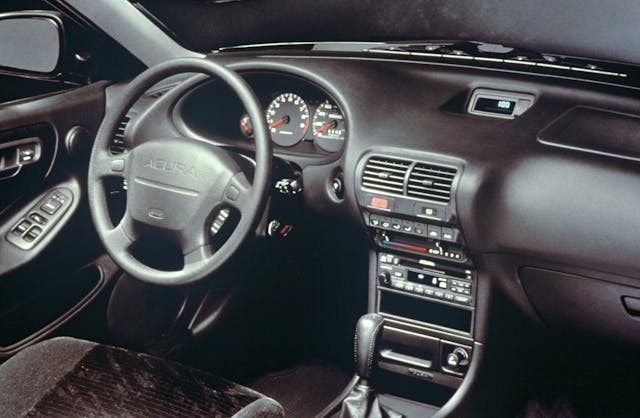
Perhaps the best thing about the Integra Type R is the unassuming styling. It could be any Integra, except for the chin spoiler up front and the high wing in the rear. Inside, there was a bit more going on, including the Type R-spec ignition key, grippy faux suede racing buckets, the leather wrapped wheel and gearshift knob, the carbon-fiber-esque instrument panel and the number plate on the console, indicating that you were one of the proud few to own one.
In 1997, the only color available was the one pictured in the brochure: Championship White. Only 2560 Integra Type Rs were sold in North America.
1998
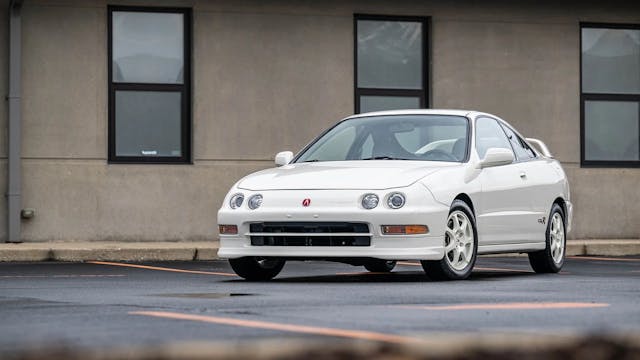
The brochure changed in 1998, but not much else did. Championship White was still the only color. The brochure does mention that an “Air conditioning kit” is available as an accessory, probably because Acura dealers were grousing that they couldn’t sell the car without it. In 1998, Acura sold 2577 Integra Type Rs in North America.
1999
And then it was gone. There was no Integra Type R for 1999.
2000
It came back! In essence, the 2000 model year car is the same as the one offered in 1997 and 1998, only with new dark-silver aluminum wheels, a titanium-finish shift knob, carbon-fiber “styled” vents and trim, and two new colors replacing Championship White: Flamenco Black Pearl and Phoenix Yellow. For 2000, Acura sold 2633 Integra Type Rs in North America.
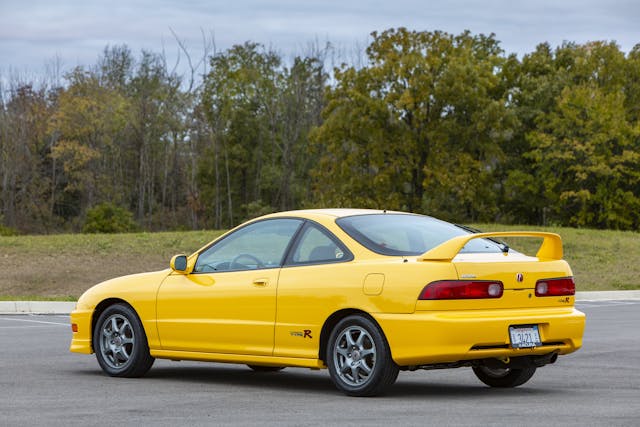
2001
For the final year of DC2 production, changes were limited to colors. Phoenix Yellow stayed, but Flamenco Black Pearl exited in favor of Nighthawk Black Pearl. For the 2001 model year, Acura sold 2639 Integra Type Rs in North America.
Before You Buy
Engine/Driveline
We checked in with several DC2 owners and experts about the Integra and the Type R. Tyson Hugie works a 9-to-5 as a financial analyst for an Arizona-based hospital system, but his passion is cars, specifically those from Honda and Acura. He has owned 28 Acuras, including five Integras over his driving career. As of November 2021, his current two Integras are a 1989 LS five-door in Polar White and a 1992 GS-R 3-door in Aztec Green Pearl (the latter with over 250,000 miles on its original B17 VTEC engine).
With all due respect to Dorothy Parker, hell isn’t other people; it’s the previous owner. Hugie notes that the key to a successful Integra purchase—regardless of the trim level—is knowing how the car was driven. “Because of the rev-happy nature of the Integra’s B-series motors, tachometer redlines start at 6800 rpm for LS and GS trim levels, 8000 for GS-R, and a sky-high 8400 for the Type R,” he says. “They also have gearing that results in high-rpm highway cruising.
“As a result, a lot of these cars have been wrung out and can be susceptible to oil burning. Keep an eye out for smoke from the tailpipe, especially after an extended idle, and watch the level on the dipstick.”

Erick Calderon—another DC2 Integra owner and a Honda Service Advisor, who currently owns a 1991 Acura Integra RS, 1993 Acura Integra GS-R, and a 1996 Acura Integra GS-R—also cites humanity at large as the Type R’s biggest problem. “Some GS-R or Type-R DC2 Integras have had their original powertrain either stolen or just replaced by their non-VTEC counterparts,” he says.
Aside from that, Hugie says, Integra maintenance is as straightforward as it would be for any 1990s-era Honda. Timing belts and water pumps—which should be replaced together at 90,000-mile intervals—are key. He notes that OEM parts are still readily available, and preferable to aftermarket alternatives.
Body
Rust is always an issue with older cars, but less so with cars of the DC2’s vintage. What is more important is finding a car that wasn’t crashed. For a time, the 1999 Integra (all trims) was the most stolen car in America; you can bet a lot of those ended up being patched back together.
Hugie and Calderon both urge careful inspection of the VIN stickers on the doors, hatch, hood, and fenders. “Beware that there are also companies out there that make replica VIN stickers, too,” says Hugie. “Factory Honda ones will have a watermark on them.”
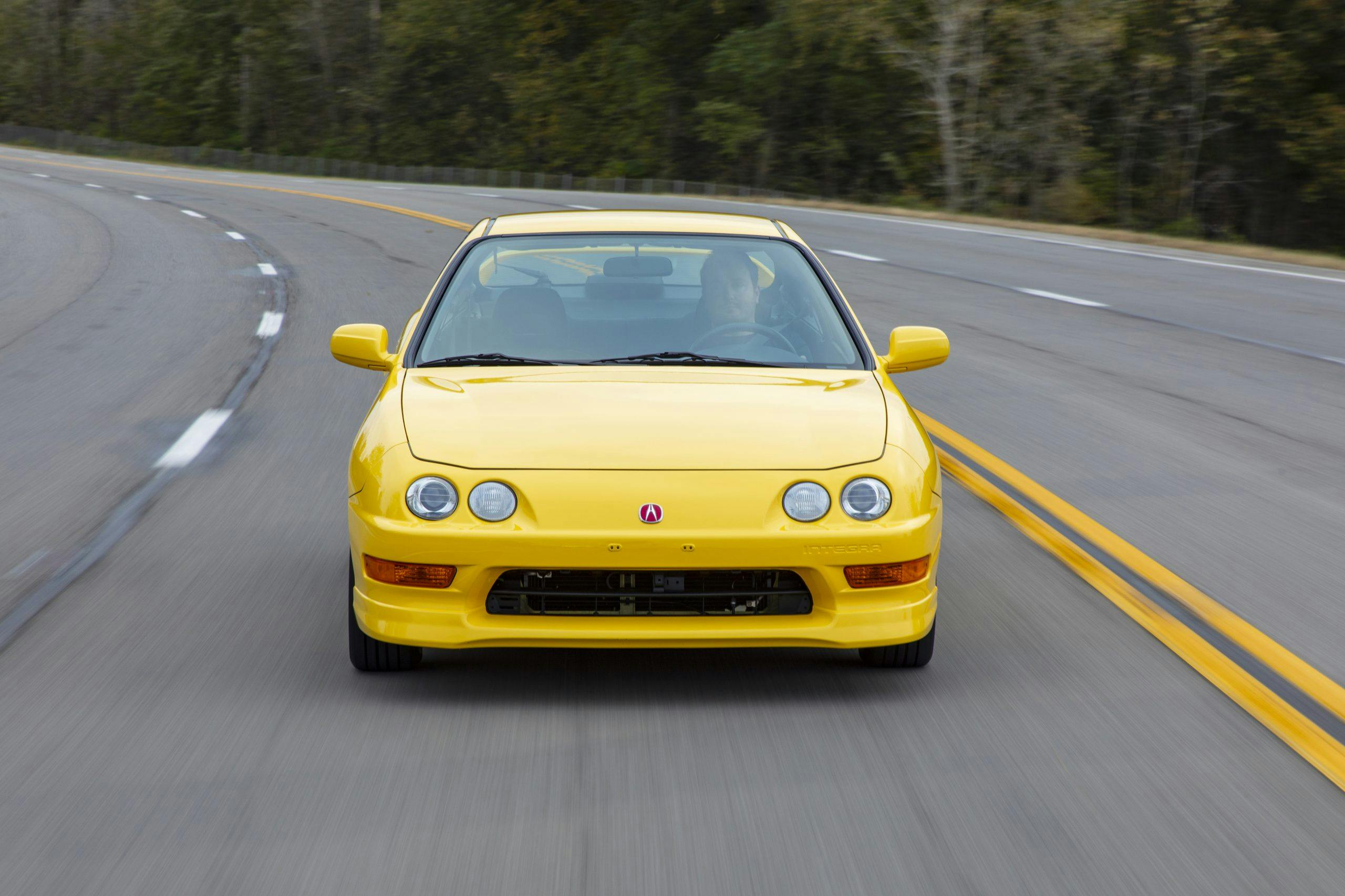
Rust damage reveals itself inside the spare-tire well. “Also, give the sliding moonroof a back-and-forth run,” says Hugie. “The moonroof on the DC2 Integra extends out above the roof instead of retracting within the headliner, and movement is known to be a little jittery if the system needs lubrication.”
Searching for collision damage, Hugie mentions careful inspection of the bumper covers. “The front and rear bumpers came with “INTEGRA” embossed on the right-hand side, under the driver’s headlight up front, and under the passenger taillight at the rear,” he says “If the wording is not there, that’s a tell-tale way of knowing the car has aftermarket parts.”
Calderon also advises taking a close look at the window-trim moldings. “They tend to warp or fade,” he says. “Most are no longer available.”
Suspension
“Handling and driver feedback are some of the Integra’s greatest attributes,” says Calderon. “Replacing worn bushings is key for restoring driving feel.”
Beyond that, both agree there’s nothing much else to look for aside from the usual worn-out components. You won’t find Bridgestone Potenza RE010s in 195/55R15 sizes any longer. Even the car that Acura keeps in a museum has replacement Dunlop Direzzas.
Originality
As with most special editions, one of the biggest concerns is ensuring a potential Integra Type R still has all the unique parts with which the factory blessed it. Have a look at the video embedded above to see them in detail. Here’s a short list:
- Type R–branded front and rear strut-tower brace
- B18 engine and Type R transmission (check the VIN tags to ensure a match)
- Rear trunk brace
- Amber backlit gauge cluster
- Alcantara seats with red stitching
- Type R–specific shift knob
- Type R–specific door panel inserts
- Type R build series plaque on console
- Type R five-lug wheels
- Rear suspension cross-member brace
If all of the above are present and accounted for, you likely found an unmolested Integra Type R. But it never hurts to go a little further and consult the folks at the Type R Club of America to ensure you are truly getting what you pay for.
Valuation
In the last five years, DC2 Type Rs have only gotten hotter. In May of 2018, a first-year ITR in #2, or Excellent, condition was worth around $40K; as of April, 2023, that same car would run you $65,500. More recently, values across the model years have leveled out. In the last two years, 1998–2001 cars have pulled even with the first-year examples, which in 2021 carried a $5500 premium. All have appreciated: The value of an ITR from any year in #2, or Excellent, condition has increased by nearly $15K. Check here for the latest, model-year-specific data.
As values for left-hand-drive, U.S.-spec ITRs began to explode around 2020, people’s interest in the JDM versions—badged as Hondas—soared. More and more were imported stateside, thanks in part to the earlier production start (1995). Once, RHD Type Rs carried a decent discount; however, as with Mk IV Supras and FD RX-7s, the value different between USDM and JDM cars is closing rapidly. In the case of the Integra Type R, the gap between JDM and USDM hatchbacks has narrowed from 26 percent to just 14 in the last two years. The sedan version of the ITR bears out the trend: Offered only for the Japanese market, it was once worth only half as much as a USDM hatchback; as of 2023, the value difference between the two has narrowed from 50 percent to just 30.
Millennials are the driving force with Integra values; they quote 53 percent of Integra Type Rs, while making up just 22 percent of the market overall. Gen X, the generation responsible for the purchase of these cars in the first place, quote 34 percent of Integra Type Rs, and represent 32 percent of the market overall. Gen Zs are no longer overlooking them, either: In 2021, this generation accounted for just 1 percent of ITR quotes; today, they account for 8, a share proportionate to their slice of the collector-car market.
Boomers and pre-Boomers, meanwhile, haven’t changed their attitudes towards the DC2 Type R. The former represent 34 percent of Hagerty customers but only 5 percent of Integra Type-R quotes. Pre-boomers? Not even on the ITR’s quote radar.
“The third-generation Integra is a masterpiece of a machine for avid drivers,” says Hugie. “It’s a car that delivers a raw sense of control and speed, from an era just before driver-assistance features started taking over the experience of being behind the wheel.” With strong interest, and a solid group of younger owners, don’t expect the value of a Type R to come down any time soon.
***
Check out the Hagerty Media homepage so you don’t miss a single story, or better yet, bookmark it. To get our best stories delivered right to your inbox, subscribe to our newsletters.



The Type R is my favorite Integra. Such a fun analog high revving car that we will never see something like it again.
Again… Your comment is awaiting moderation.
There is no such thing as USDM for Honda / Acura. The “D” standing for “domestic” means the home market. Honda is a Japanese company based in Japan. Not USA.
80s baby. We blessed with some bad@$$ cars in the 80s & 90s….